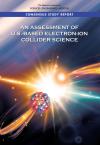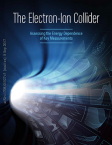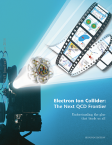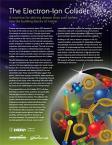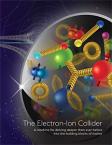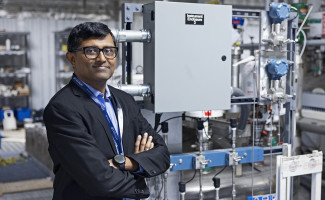Cryogenics pro designs systems to be used on-site, in labs around the world
Ritendra Bhattacharya is known for keeping things cool—cold, really. As deputy department head of the Cryogenics department at the U.S. Department of Energy’s Thomas Jefferson National Accelerator Facility, Bhattacharya leads the cryogenics engineering group and helps to maintain the five cryogenics plants operating throughout the lab.
Each cryogenic plant serves a unique function and needs to be operative 24/7 and 365 days a year using an unsupervised computer control system.
As far as Bhattacharya is concerned, cryogenics is his dream field.
“As a student, I learned all about various types of subsections that go into the field of cryogenics— such as thermodynamics, physics and electronics —and the area became very interesting to me,” he says. “That’s how I ended up joining the cryogenics group and I haven’t regretted it once. I haven’t thought of going to any other field. I love it.”
When Bhattacharya joined the lab in 2017, he brought 15 years of experience working on “the distribution side” of cryogenics technology, largely for the groundbreaking ITER project. ITER is a magnetic fusion device that will help to determine the feasibility and requirements of using plasma fusion to generate clean energy on a large scale.
At the lab, Bhattacharya’s focus is on “the refrigerator side” of cryogenics, which he describes as the process of developing systems capable of cooling and storing large amounts of helium.
He serves as the technical lead for a project to upgrade the Cryogenic Test Facility (CTF), which provides cryogenic services for the Test Lab to support the Vertical Test Area (VTA), the Cryomodule Test Facility (CMTF) and the Upgrade Injector Test Facility (UITF).
Bhattacharya is also the technical lead for the 4 kilowatt at 4.5 Kelvin End Station Refrigerator 2 (ESR2) upgrade that will provide cryogenic support for the upcoming Measurement of a Lepton-Lepton Elastic Reaction (MOLLER) collaboration experiment, which will take place in Hall A.
Additionally, he provides ongoing support as the commissioning lead for the Linac Coherent Light Source-II (LCLS-II) cryoplant at the DOE’s SLAC National Accelerator Laboratory.
Outside of his lab duties, Bhattacharya is still somewhat involved in ITER, which is scheduled to run in 2025.
“I do have multiple interests involving cryogenics,” Bhattacharya admits. “One side puts me on a quest to produce green energy and the other is to understand basic atomic structure more.”
Cryogenics is indispensable component of many nuclear physics experiments
Cryogenics is a field distinguished by the use of temperatures of -153℃ (about -307°F) and lower. According to Bhattacharya, cryogenics is an “indispensable component” in experiments run throughout the lab as it “provides crucial utilities to the lab’s superconducting machines so our colleagues can focus more on the research.”
(about -307°F) and lower. According to Bhattacharya, cryogenics is an “indispensable component” in experiments run throughout the lab as it “provides crucial utilities to the lab’s superconducting machines so our colleagues can focus more on the research.”
Bhattacharya’s first project at the lab was to use his cryogenics expertise to work on California-based LCLS-II project at SLAC.
“SLAC originally had a room-temperature accelerator, and they planned to convert it to a superconducting accelerator,” he explains. “Our team was responsible for producing the cryogenic hardware for it, which we designed and fabricated at the lab and then sent to SLAC. They are turning on the cryogenic components one-by-one and testing them now. We have now transitioned to being consultants as the team at SLAC gets the system up and running.”
Back at the lab, Bhattacharya has turned his attention to developing the ESR2 upgrade that is needed for MOLLER. MOLLER will use an 11 GeV longitudinally polarized electron beam to make a precise measurement of the weak mixing angle of scattered electrons.
“The refrigerator we’re refurbishing for MOLLER was originally built for a Superconducting Super Collider project in the 1990’s,” Bhattacharya says. “The refrigerator was built, commissioned and run for six months to a year. Then, that machine was decommissioned and kept in storage at the lab until we started this project in 2019.”
To prepare the machine, Bhattacharya and his team have stripped out the old materials and are rebuilding the system with upgraded components.
“My role is to make sure we design and fabricate everything—and commission the machine—in order to provide the cryogenics support needed for the work scientists are doing here,” he says.
ITER project remains ongoing
In contrast to the basic science mission that Bhattacharya supports at Jefferson Lab, the ITER project he continues to follow is designed to functionally change the favored energy source for power plants on a global scale.
ITER is one of the “most ambitious” energy projects in the world, according to its website. Once finished, it will be the world’s largest tokamak—or magnetic fusion device. The goal of ITER is to revolutionize the way power plants generate power by employing plasma fusion, which is safer and more efficient than current large-scale power production methods.
“It’s like we are making the sun on Earth and then turning the energy the sun gives off into electricity to power entire communities,” explains Bhattacharya.
During his years working on ITER, Bhattacharya’s roles included cryogenic co-coordinator and deputy cryogenic project team leader. His team included about 20 engineers responsible for executing the design, fabrication and installation of cryogenic distribution including cryogenic transfer lines for ITER.
“The ITER project is a really big project,” Bhattacharya recognizes. “I still feel honored to have been a part of it from 2006 to 2017 during the phase of development the Indian Domestic team was involved with.”
By Carrie Rogers





